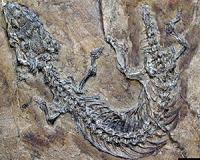 |
New Haven CT (SPX) May 26, 2011 Paleontologists have discovered that a group of remarkable ancient sea creatures existed for much longer and grew to much larger sizes than previously thought, thanks to extraordinarily well-preserved fossils discovered in Morocco. The creatures, known as anomalocaridids, were already thought to be the largest animals of the Cambrian period, known for the "Cambrian Explosion" that saw the sudden appearance of all the major animal groups and the establishment of complex ecosystems about 540 to 500 million years ago. Fossils from this period suggested these marine predators grew to be about two feet long. Until now, scientists also thought these strange invertebrates-which had long spiny head limbs presumably used to snag worms and other prey, and a circlet of plates around the mouth-died out at the end of the Cambrian. Now a team led by former Yale researcher Peter Van Roy (now at Ghent University in Belgium) and Derek Briggs, director of the Yale Peabody Museum of Natural History, has discovered a giant fossilized anomalocaridid that measures one meter (more than three feet) in length. The anomalocaridid fossils reveal a series of blade like filaments in each segment across the animal's back, which scientists think might have functioned as gills. In addition, the creature dates back to the Ordovician period, a time of intense biodiversification that followed the Cambrian, meaning these animals existed for 30 million years longer than previously realized. "The anomalocaridids are one of the most iconic groups of Cambrian animals," Briggs said. "These giant invertebrate predators and scavengers have come to symbolize the unfamiliar morphologies displayed by organisms that branched off early from lineages leading to modern marine animals, and then went extinct. Now we know that they died out much more recently than we thought." The specimens are just part of a new trove of fossils from Morocco that includes thousands of examples of soft-bodied marine fauna dating back to the early Ordovician period, 488 to 472 million years ago. Because hard shells fossilize and are preserved more readily than soft tissue, scientists had an incomplete and biased view of the marine life that existed during the Ordovician period before the recent discoveries in Morocco. The animals found in Morocco inhabited a muddy sea floor in fairly deep water, and were trapped by sediment clouds that buried them and preserved their soft bodies. "The new discoveries in Morocco indicate that animals characteristic of the Cambrian, such as the anomalocaridids, continued to have a considerable impact on the biodiversity and ecology of marine communities many millions of years later," Van Roy said. A video of Derek Briggs discussing the fossils, along with a model of the anomalocaridid creature, is available here. A video of Derek Briggs discussing the fossils, along with a model of the anomalocaridid creature, is available at here. The paper appears in the May 26 issue of the journal Nature. DOI: 10.1038/nature09920
Share This Article With Planet Earth
Related Links Yale University Explore The Early Earth at TerraDaily.com
 Lizard fossil provides missing link in debate over snake origins
Lizard fossil provides missing link in debate over snake originsToronto, Canada (SPX) May 25, 2011 Until a recent discovery, theories about the origins and evolutionary relationships of snakes barely had a leg to stand on. Genetic studies suggest that snakes are related to monitor lizards and iguanas, while their anatomy points to amphisbaenians ("worm lizards"), a group of burrowing lizards with snake-like bodies. The debate has been unresolved--until now. The recent discovery by research ... read more |
|
| The content herein, unless otherwise known to be public domain, are Copyright 1995-2010 - SpaceDaily. AFP and UPI Wire Stories are copyright Agence France-Presse and United Press International. ESA Portal Reports are copyright European Space Agency. All NASA sourced material is public domain. Additional copyrights may apply in whole or part to other bona fide parties. Advertising does not imply endorsement,agreement or approval of any opinions, statements or information provided by SpaceDaily on any Web page published or hosted by SpaceDaily. Privacy Statement |